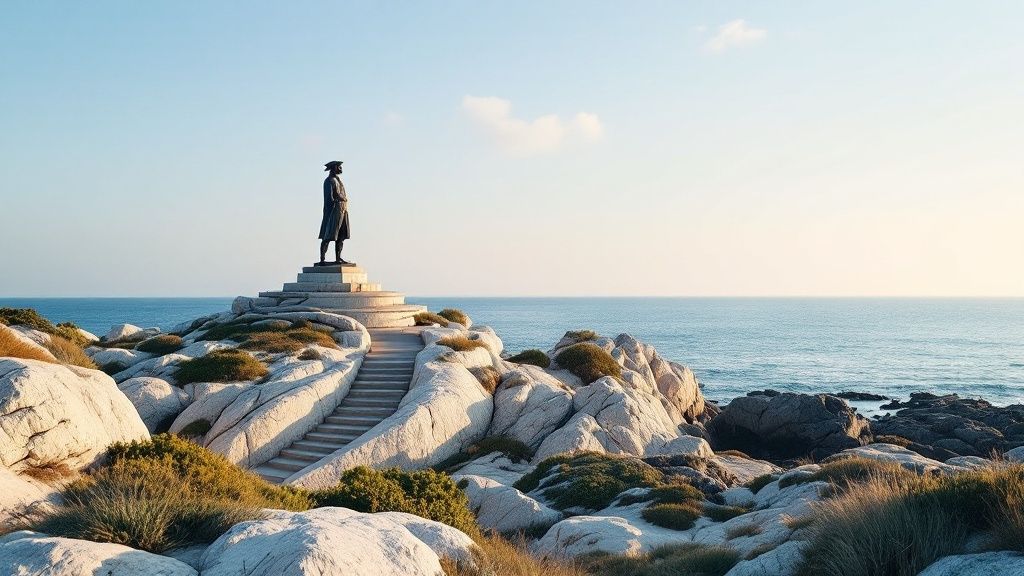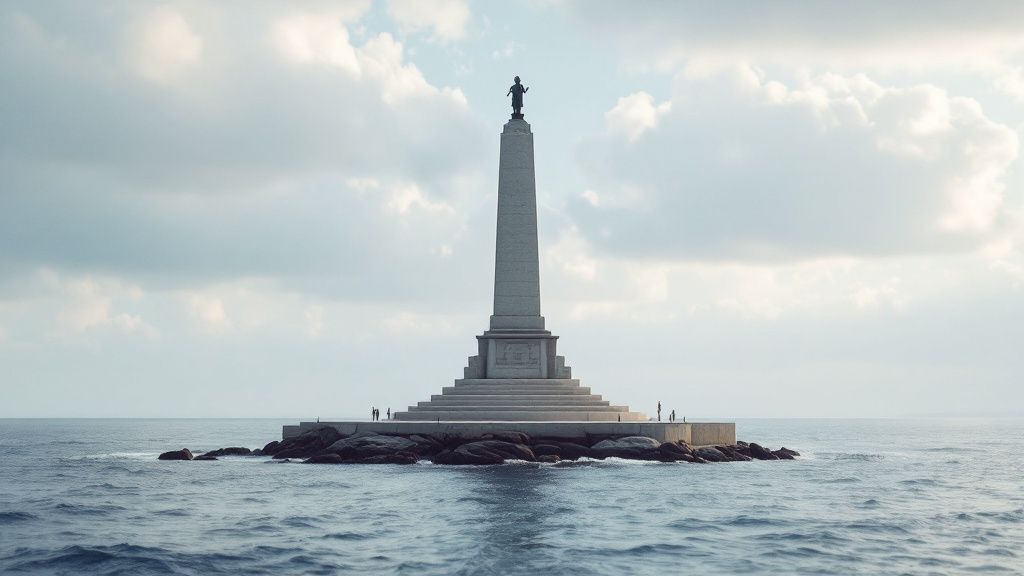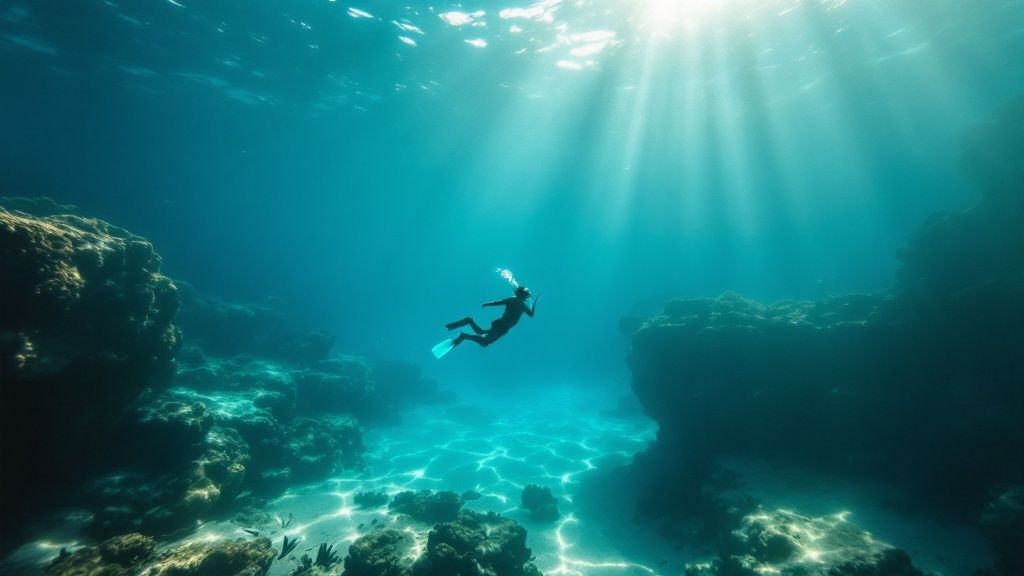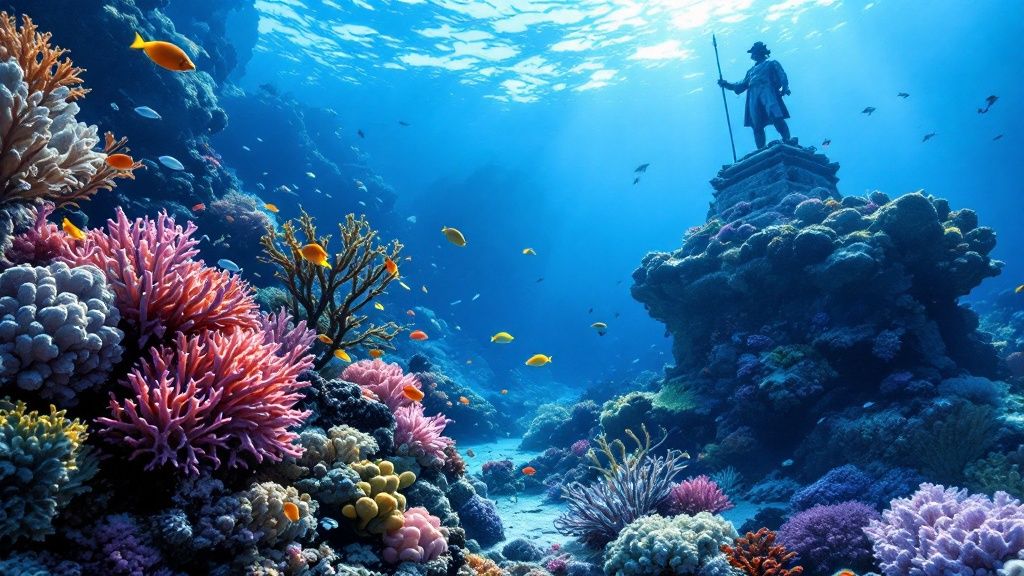Captain Cook Monument Snorkeling: Explore Hawaii Reefs

The Fascinating History Behind Captain Cook Monument

Captain Cook Monument snorkeling offers a unique experience, blending history and the natural world. The monument, erected in 1874, commemorates a significant moment in Hawaiian history. This exploration delves into the importance of Kealakekua Bay and its evolution into a popular snorkeling spot.
Captain Cook's Arrival and Legacy
In 1778, Captain James Cook made the first recorded contact between Hawaiians and Europeans. Initially met with welcome, Cook's interactions with the islanders grew complicated, ultimately leading to his death in 1779 at Kealakekua Bay, the exact location of the present-day monument. This event profoundly impacted the course of Hawaiian history and its connection with the West, imbuing the monument's location with deep historical significance.
From Historical Site to Snorkeling Paradise
After these events, Kealakekua Bay transformed from a place of conflict to a protected sanctuary. The monument's construction further solidified its importance. The bay's inherent beauty and thriving marine ecosystem gradually attracted attention, establishing it as a prime snorkeling location. Now, snorkelers can explore vibrant coral reefs filled with marine life while reflecting on the historical echoes surrounding them.
Kealakekua Bay attracts over 100,000 visitors annually, drawn to its rich history and vibrant marine life. The bay, where Captain James Cook first landed in Hawaii in 1778 and later met his demise in 1779, holds profound significance. The 1874 monument symbolizes the intersection of Hawaiian and Western cultures, enriching the snorkeling experience. Its designation as a Marine Life Conservation District safeguards the ecosystem, making it an ideal place for snorkeling and historical contemplation. Learn more about Captain Cook snorkeling here.
The Monument's Impact on the Underwater Experience
The monument itself has fostered an artificial reef, drawing diverse marine species to its base. This has enriched the snorkeling experience, providing a captivating focal point and unique underwater structure for exploration. Snorkeling at Captain Cook Monument isn't just about observing marine life; it's about swimming through history. The monument acts as a tangible connection to the past, reminding visitors of the significant events that transpired in this remarkable location. The fusion of history and natural beauty creates a truly memorable experience.
Underwater Treasures: Marine Life You'll Actually See

Forget generic descriptions of coral and fish. Captain Cook monument snorkeling offers a vibrant encounter with specific marine species. This section explores the unique underwater world you'll discover, from dazzling reef fish to graceful sea turtles.
A Kaleidoscope of Reef Fish
The reefs surrounding the Captain Cook monument teem with a diverse population of fish. You're almost certain to see the bright yellow Yellow Tang, an iconic Hawaiian species.
Also, keep an eye out for the Raccoon Butterflyfish, easily identifiable by its distinctive black "mask." Every glance reveals a new splash of color and unique fish behavior, creating an unforgettable underwater spectacle.
Endemic Wonders: Hawaiian Exclusives
Hawaii's isolated location has resulted in a high number of endemic species—species found nowhere else on Earth. The Humuhumunukunukuapua'a, Hawaii's state fish, is a frequent sight while snorkeling at the monument. Discovering these unique creatures adds a special dimension to your snorkeling adventure.
Gentle Giants: Spotting Sea Turtles
The chance to swim alongside Hawaiian green sea turtles is a highlight for many. These graceful creatures often graze on algae growing on the reef. Remember, they are wild animals and should be observed respectfully from a distance to ensure their safety and the ecosystem's natural balance.
For more information on respecting marine wildlife, check out our guide on responsible snorkeling practices.
The following table highlights some of the common marine life you might encounter during your snorkeling adventure:
To help you better understand what to look for while exploring the Captain Cook Monument, we've compiled the following table:
"Marine Life Species at Captain Cook Monument" displays common marine species you might encounter while snorkeling at the monument. It offers insights into the likelihood of spotting them, the best viewing times, and some interesting facts about each species.
| Species | Likelihood of Sighting | Best Time to See | Interesting Facts |
|---|---|---|---|
| Yellow Tang | Very High | Daylight hours | These bright yellow fish are herbivores and play a crucial role in keeping algae growth in check. |
| Raccoon Butterflyfish | High | Daylight hours | Their "mask" helps camouflage them from predators and they are often seen in pairs. |
| Humuhumunukunukuapua'a (Reef Triggerfish) | Medium | Daylight hours | Hawaii's state fish, they can make grunting noises and have a spine on their back that they can raise for defense. |
| Hawaiian Green Sea Turtle | Medium | Daylight hours | These gentle giants can hold their breath for hours and are often seen grazing on algae. |
| Spinner Dolphin | Low | Early morning/Late afternoon | Known for their acrobatic leaps and spins, they often travel in pods. |
This table summarizes some of the fascinating creatures you might encounter while snorkeling at the Captain Cook Monument. Remembering these key details will enrich your experience and help you identify the diverse marine life that calls this area home.
Dolphins and More: Occasional Visitors
While not always present, spinner dolphins frequent Kealakekua Bay, often in pods. These playful creatures are known for their acrobatic leaps and spins, adding excitement and surprise to your snorkeling trip. During winter, you might even glimpse migrating humpback whales in the distance, a truly awe-inspiring sight.
The Coral Ecosystem: A Foundation of Life
The vibrant coral reefs are the foundation of this diverse ecosystem. These underwater "cities" provide shelter and food for countless marine animals. Observing the intricate coral formations and the life they support offers a fascinating glimpse into the interconnectedness of the underwater world. This delicate balance highlights the importance of responsible snorkeling practices.
Avoid touching the coral and use reef-safe sunscreen to help protect this vital habitat. These small actions have a significant impact on preserving this precious ecosystem for generations to come.
Crystal Waters: What Makes This Spot Exceptional

The clarity of the water at the Captain Cook Monument draws snorkelers from around the world. But what makes this visibility so exceptional? This section dives into the unique combination of elements that create this underwater paradise.
The Role of Freshwater Springs
Underwater freshwater springs are key to Kealakekua Bay's remarkable water clarity. These springs act as a natural filtration system, constantly cleansing the bay of sediments and pollutants. This continuous flow of fresh water contributes to the astounding 100-foot visibility often seen in the bay. This pristine environment makes it ideal for viewing the colorful coral reefs and the diverse marine life that calls Kealakekua Bay home.
Ocean Currents and Topography
The ocean currents also play a significant role in maintaining the bay's exceptional clarity. The currents in Kealakekua Bay circulate in a specific pattern, keeping the water clear and debris-free. This contrasts sharply with nearby beaches where different current patterns can result in much murkier water. The bay's unique topography also provides a natural shield against strong waves and storms, further enhancing visibility. These natural barriers minimize sediment disturbance, allowing the water to remain incredibly clear.
Kealakekua Bay, home to the Captain Cook Monument, provides superb snorkeling conditions in Hawaii. With an average visibility of 100 feet and an average depth of approximately 25 feet, the bay caters to both beginners and experienced snorkelers. Some areas reach depths of 153 feet, supporting a rich variety of marine life, including species unique to this area. The bay's designation as a Marine Life Conservation District helps protect this thriving underwater ecosystem. Find more detailed statistics at Kona Snorkel Trips.
The Science Behind the Blue
The vibrant blue hues of Kealakekua Bay are not just aesthetically pleasing; they're a direct result of the way light interacts with the water. Clear water absorbs longer wavelengths of light, like reds and oranges, while reflecting the shorter blue wavelengths. This phenomenon, known as light scattering, creates the captivating blue color that snorkelers revel in.
Protected Status and Preservation
Kealakekua Bay's protected status as a Marine Life Conservation District is crucial for maintaining its pristine condition. This designation restricts potentially damaging activities and helps prevent the environmental degradation seen in other snorkeling locations. This protection ensures the long-term health of the coral reefs and the continued exceptional visibility. It also safeguards the diverse marine life that thrives within the bay. Learn more about snorkeling at Kona Snorkel Trips.
Timing Your Visit for Optimal Clarity
Even in a naturally clear location like Kealakekua Bay, timing is important. Weather patterns can influence visibility. Calm, sunny days typically offer the best conditions. Checking local weather forecasts and opting for morning snorkeling, when the water is generally at its calmest and clearest, can greatly improve your experience. For tips on choosing the right gear, check out Kona Snorkel Trips. Areas near the monument itself are renowned for consistently excellent visibility thanks to the freshwater springs.
Maximizing Your Experience
Understanding the factors that affect water clarity can help you maximize your snorkeling adventure at the Captain Cook Monument. Choosing the right time to visit, selecting specific locations within the bay known for their exceptional visibility, and respecting the delicate environment will all contribute to a truly unforgettable underwater experience.
Getting There: Insider Methods to Reach the Monument

Planning your snorkeling adventure to the Captain Cook monument is key to a rewarding experience. Each way to access the monument offers a unique perspective of this incredible site. Let's explore the different options, weighing the pros and cons of each, so you can choose the perfect way to begin your snorkeling adventure.
By Boat: A Comfortable and Scenic Option
Several boat tours depart from Keauhou Bay, providing a comfortable and scenic journey to the monument. This is undoubtedly the easiest option, particularly for families or those who prefer not to hike. Some tours even offer access to exclusive snorkeling spots within the bay. However, it's worth noting that boat tours can be pricier than other methods.
Kayaking: An Active Adventure
Kayaking to the monument from Keauhou Bay is a popular choice for those seeking a more active adventure. Paddling to the monument offers a rewarding sense of accomplishment and lets you explore the coastline at your own pace. Keep in mind that this method requires a moderate level of fitness and can be tricky in windy conditions. Choosing a reputable kayak operator with a solid safety record is essential. For additional tour and activity information, check out the Kona Snorkel Trips Sitemap.
Hiking the Captain Cook Monument Trail: A Challenging Trek
For a more challenging but incredibly rewarding experience, consider hiking the historic Captain Cook Monument Trail. This 3.7-mile out-and-back hike descends 1,256 feet to Kealakekua Bay, revealing breathtaking views of the coastline and Mauna Loa volcano. Be prepared for the steep terrain, especially on the return uphill climb. Packing plenty of water (at least 1 gallon per person) and wearing sturdy footwear is crucial. This demanding hike is an immersive journey through varied landscapes, from lush forests to rugged lava fields.
Timing and Etiquette: Respecting the Bay
No matter your chosen access method, timing your arrival can significantly enhance your snorkeling experience. Arriving early in the morning lets you avoid the midday heat and the often strong afternoon winds, which can impact kayaking and boat travel. Respecting local customs and the cultural significance of the bay is also paramount. This bay holds deep meaning for Native Hawaiians, so treating the site with reverence is essential. Avoid loud noises, and refrain from touching or disturbing any historical or natural features.
Comparing Your Options: Making the Right Choice
To help you decide, the following table summarizes the different ways to reach the Captain Cook monument, comparing cost, time commitment, and physical demands.
To help you make the best decision for your snorkeling adventure, let's compare the key features of each access method:
Comparing Ways to Access Captain Cook Monument
Comparison of different methods to reach the Captain Cook Monument for snorkeling
| Access Method | Approximate Cost | Time Required | Physical Difficulty | Permits Required | Pros | Cons |
|---|---|---|---|---|---|---|
| Boat Tour | $$ (Varies by operator) | 1-2 hours each way | Low | Not typically required for standard tours | Comfortable, scenic, access to exclusive spots | Most expensive option |
| Kayak | $ (Rental fees apply) | 2-3 hours each way | Moderate | May be required depending on launch location | Active adventure, explore at your own pace | Requires moderate fitness, challenging in wind |
| Hike | Free (Parking fees may apply) | 3-6 hours roundtrip | High | Not required | Stunning views, immersive experience | Strenuous hike, requires good physical condition |
By considering these factors, you can select the access method that best suits your needs and ensures a truly memorable snorkeling experience at the Captain Cook monument. You'll be well-prepared to enjoy the remarkable blend of history, natural beauty, and underwater wonders that awaits you.
Essential Gear and Real Safety Protocols
Snorkeling at the Captain Cook monument is an unforgettable experience, but it requires preparation. Safe and fulfilling exploration of Kealakekua Bay goes beyond basic gear. This guide, drawing on insights from local rescue professionals and seasoned guides, provides specific recommendations for this unique location and emphasizes often-overlooked safety measures.
Gear Optimized for Kealakekua Bay
Standard snorkel gear is a good starting point, but some equipment performs better in Kealakekua Bay’s specific conditions. A low-volume mask, minimizing the space between your eyes and the lens, significantly improves visibility. Some masks even offer a wider field of vision, crucial for observing diverse marine life. A dry-top snorkel, preventing water from entering the tube, is another valuable addition, especially in choppy water. Finally, ensure your fins fit comfortably and provide effective propulsion in the bay’s distinct current patterns.
Sun Protection: Beyond the Basics
Protecting yourself from the Hawaiian sun at Kealakekua Bay requires more than just sunscreen. While reef-safe sunscreen is vital for preserving the coral, it might not be enough to shield you completely. The sun's reflection off the water intensifies its effects, increasing the risk of sunburn. Wearing a rash guard or other protective clothing provides an extra layer of defense against the sun’s harmful rays. Staying hydrated is also essential. Experienced guides often suggest hydration packs over single-use plastic bottles. This approach keeps you hydrated and minimizes plastic waste in this fragile environment.
Safety Protocols: Local Insights
Snorkeling at the Captain Cook monument presents unique safety considerations. Local rescue professionals stress the importance of understanding the bay's current patterns. They recommend entering the water up-current and allowing the current to carry you along the reef. This technique saves energy and minimizes the risk of being swept out to sea. However, even strong swimmers should stay vigilant about changing conditions. The seemingly calm waters can shift rapidly. Be aware of warning signs, such as increasing wind or changes in wave patterns, which are critical for your safety.
Conservation Concerns: Protecting the Bay
Protecting the bay's delicate ecosystem is vital for all who enjoy it. While many visitors are mindful of their impact, some seemingly harmless actions can be damaging. For instance, even lightly touching the coral can disrupt its growth and health. Anchoring boats directly on the reef can also cause significant harm. Choosing tour operators who prioritize sustainable practices, such as using mooring buoys instead of anchoring, helps protect this valuable resource. Understanding and respecting these concerns ensures your visit contributes to the bay’s preservation.
Emergency Preparedness
While emergencies are rare, preparation is key. Familiarize yourself with the specific emergency protocols for Kealakekua Bay, which might differ from general guidelines. Knowing the location of the nearest emergency services and how to signal for help are essential. Carrying a waterproof whistle can be invaluable in unexpected situations. These precautions, while hopefully unnecessary, provide added safety and peace of mind.
Perfect Timing: When to Visit For Maximum Enjoyment
Transform your Captain Cook Monument snorkeling experience from a simple dip to an unforgettable adventure by strategically planning your visit. This isn't generic advice; it's based on local knowledge and environmental understanding.
Best Months: Beyond The Tourist Season
While Hawaii is beautiful year-round, certain months offer superior snorkeling conditions at Captain Cook Monument. The shoulder seasons (April-May and September-October) are often recommended by local meteorologists and experienced guides. These months typically offer calmer waters and fewer crowds than the peak summer months. The water temperature remains comfortable, and the marine life is still active.
Ideal Time Of Day: Catch The Early Light
Even on a perfect day, timing is everything. Morning hours, especially between 8:00 AM and 10:00 AM, provide the best visibility. The water tends to be calmer, and the sunlight angle is ideal for viewing the vibrant coral and fish. This is also when many marine species are most active, increasing your chances of a dolphin or sea turtle encounter.
Moon Phases And Water Clarity
The moon's influence on tides affects water clarity in Kealakekua Bay. During a new moon, tidal movements are minimal, often resulting in exceptionally clear water. This creates excellent conditions for underwater photography and observing the intricate details of the reef. Even during other moon phases, the bay's natural freshwater springs help maintain great visibility.
Holidays: Unexpected Opportunities
Certain holidays offer surprisingly uncrowded conditions at Captain Cook Monument. While major holidays like Christmas and New Year's are busy, consider visiting during less popular holidays like Martin Luther King Jr. Day or Presidents' Day. You might find fewer people and more availability for tours and rentals.
Microclimates And Forecasting
Hawaii's microclimates can make predicting weather tricky. Understanding local forecasts and paying attention to wind speed is crucial. Strong winds can create choppy water, reducing visibility and making kayaking or boat travel more difficult. Check the National Weather Service forecast before you go and be prepared for changes.
Itinerary Planning: Flowing With The Tides
Planning complementary activities around tidal patterns and your energy levels creates a more enjoyable day. After a morning snorkel, consider exploring nearby historical sites during the warmer midday hours. As the tide recedes in the afternoon, tide pooling can be a fantastic way to discover different marine creatures.
Book your unforgettable Captain Cook snorkeling adventure with Kona Snorkel Trips today! We offer a variety of tours and experiences to help you explore the beautiful underwater world of Kealakekua Bay.
